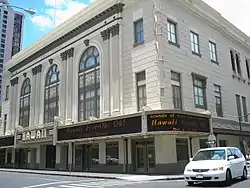Downtown Honolulu
Downtown Honolulu is the current historic, economic, and governmental center of Honolulu, the capital and largest city of the U.S. state of Hawaii. It is bounded by Nuʻuanu Stream to the west, Ward Avenue to the east, Vineyard Boulevard to the north, and Honolulu Harbor to the south. Both modern and historic buildings and complexes are located in the area, with many of the latter declared National Historic Landmarks on the National Register of Historic Places.
Downtown Honolulu | |
|---|---|
 A view of Downtown Honolulu from atop Aloha Tower | |
 Downtown Honolulu | |
| Coordinates: 21°18′12″N 157°51′26″W | |
| Country | United States |
| State | Hawaii |
| City | Honolulu |
Districts
Downtown Honolulu can be subdivided into four neighborhoods, each with its own central focus and mix of buildings. These areas are the Capitol District, the Central Business District, Chinatown, and the Waterfront.
Capitol District

The Capitol District, or Civic Center, contains most of the federal, state, and city governmental buildings and is centered on the Hawaiʻi State Capitol, ʻIolani Palace, and Honolulu Hale (city hall). It is roughly bounded by Richards Street on the west, Ward Avenue on the east, Vineyard Boulevard to the north, and Nimitz Highway to the south. Significant buildings in this area include:
- Old Advertiser Building
- Aliʻiōlani Hale
- Bishop Estate Building
- Frank F. Fasi Municipal Building
- Hawaiʻi State Capitol
- Hawaiʻi State Library
- Honolulu Fire Headquarters
- Honolulu Hale
- Honolulu Police Station
- ʻIolani Barracks
- ʻIolani Palace
- Kakaʻako Fire Station
- Kalanimoku Building
- Kamehameha V Post Office
- Kawaiahaʻo Church
- Kawaiahaʻo Plaza
- King Kalakaua Building
- Kapuaiwa Building
- Leiopapa a Kamehameha Building
- Mission Memorial Building
- The Pacific Club
- Prince Kūhiō Kalanianaʻole Federal Building
- Territorial Building
- Washington Place
Central Business District
Centered on Bishop Street and Fort Street Mall, the central business district is roughly bounded by Nuʻuanu Avenue, Nimitz Highway, Richards Street, and Vineyard Boulevard. This area contains most of the headquarters buildings of Hawaiʻi-based companies and most of the skyscrapers. Buildings in this area include:

- 1100 Alakea Street
- 1132 Bishop Street
- Alexander & Baldwin Building
- Ali'i Place
- American Savings Building
- Arcade Building
- Armstrong Building
- Army and Navy YMCA
- Bishop Bank Building
- Bishop Square
- Cades Schutte Building
- Capitol Place
- Cathedral Church of Saint Andrew
- Cathedral of Our Lady of Peace
- C. Brewer Building
- Central Fire Station
- Central Pacific Plaza (Central Pacific Bank)
- Century Square
- City Financial Tower
- Davies Pacific Center
- Dillingham Transportation Building
- Executive Center
- Financial Plaza of the Pacific (Bank of Hawaii)
- Finance Factors Center
- First Hawaiian Center
- Fort Street Mall
- Harbor Court
- Hawaiʻi Pacific University
- Hawaiian Electric Building
- Hawaiian Telcom Building
- Judd Building
- Central Middle School (Honolulu, Hawaii)
- McCandless Building
- Melchers Building
- Oʻahu Railway and Land Terminal
- Oceanit Center
- Pacific Guardian Center
- Pinnacle Honolulu
- Pioneer Plaza
- Royal Brewery
- Stangenwald Building
- Theo H. Davies Building
- TOPA Financial Tower
- Yokohama Specie Bank
- YWCA Building
Chinatown

Located between Nuʻuanu Stream and Nuʻuanu Avenue, Chinatown at one time was the center of Chinese cultural contact on the island. Central to this area is the open-air Oʻahu Market. The area around Nuʻuanu Avenue has become an Arts District, thanks to the renovation of the Hawaiʻi Theatre. Buildings in this area include:
- Hawaiʻi Theatre
- Lum Yip Kee Building
- Nippu Jiji Building
- Oʻahu Market
- Wo Fat Building
Waterfront

Honolulu's waterfront area centers on Aloha Tower, which was once the tallest building in Hawaiʻi and where cruise ships would dock before the advent of air travel between Hawaiʻi and the U.S. Mainland. Recently, cruise ships between the Hawaiian Islands now dock at Honolulu Harbor. Buildings in this area include:
Government and infrastructure
The Honolulu Police Department operates the Alapai Police Headquarters and the Downtown Police Station in Downtown Honolulu.[1]
The United States Postal Service operates the Downtown Honolulu Post Office at 335 Merchant Street.[2]
References
- "Contacting HPD Archived 2010-05-31 at the Wayback Machine." Honolulu Police Department. Retrieved on May 19, 2010.
- "Post Office Location - Downtown Honolulu." United States Postal Service. Retrieved on May 21, 2009.
External links
 Downtown Honolulu travel guide from Wikivoyage
Downtown Honolulu travel guide from Wikivoyage